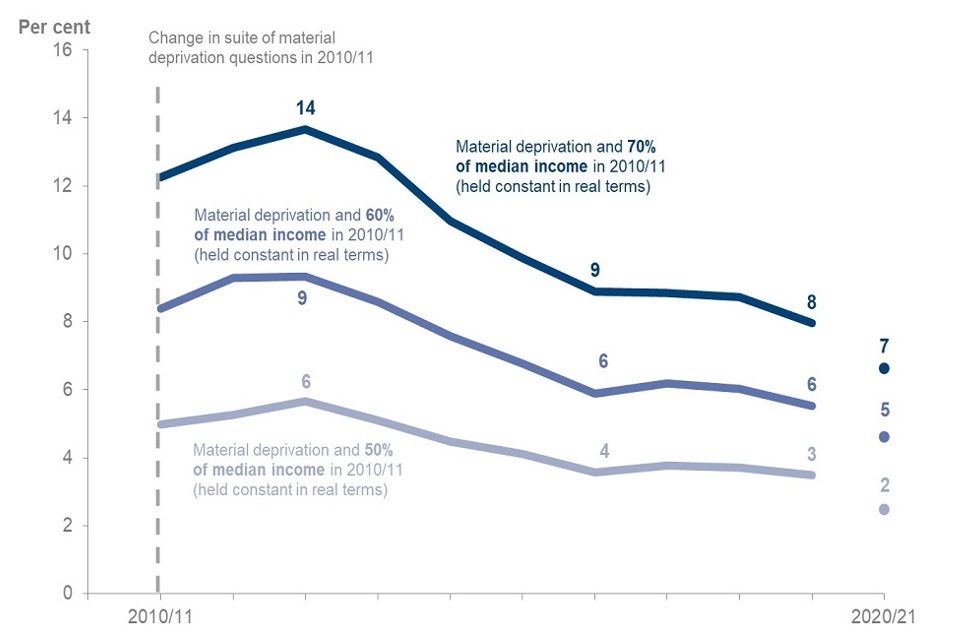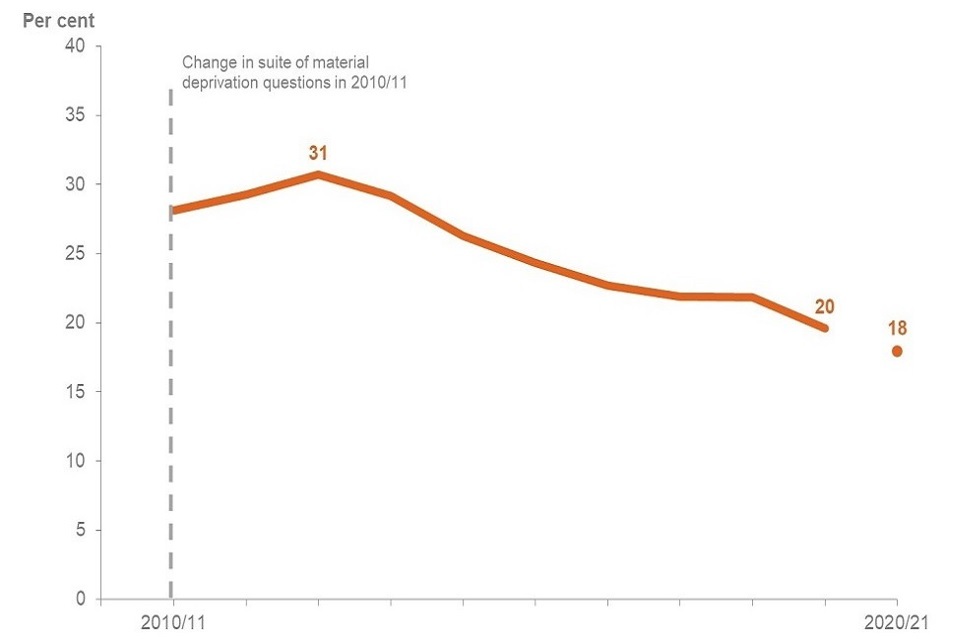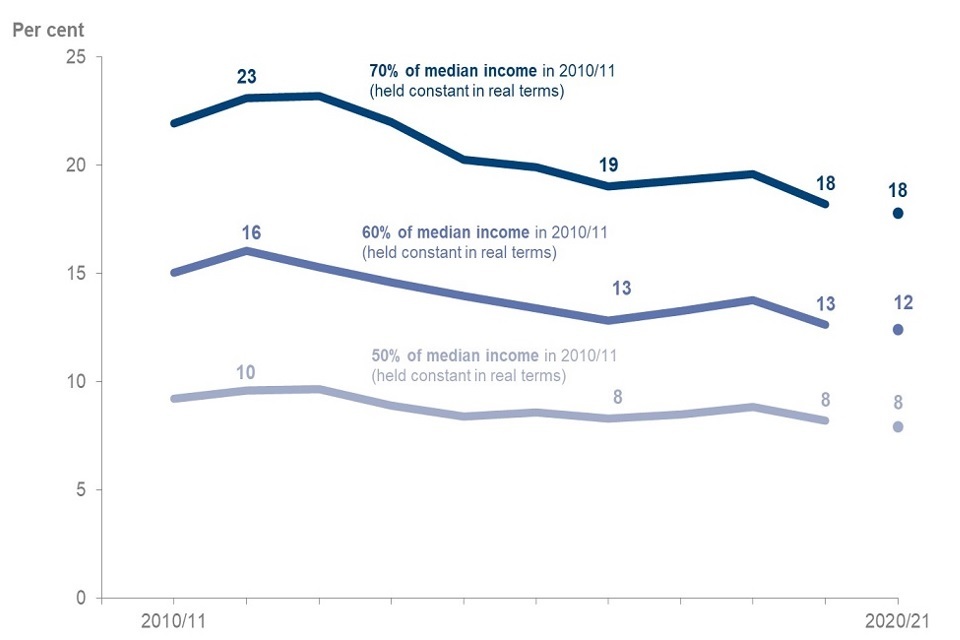Working age combined absolute low income and material deprivation estimates FYE 2011 to FYE 2021
Updated 23 February 2023
Future releases
This statistical series has ended as a separate release. The statistics are now included in the annual Households Below Average Income (HBAI) releases.
The Working Age Combined Absolute Low Income and Material Deprivation Experimental Statistics publication presents initial estimates for the number and percentage of working age adults living in absolute low income (before housing costs) and material deprivation between the Financial Year Ending (FYE) 2011 to the FYE 2021. This publication is derived from data from the Households Below Average Income (HBAI) series.
We welcome all feedback on the content, relevance, accessibility and timing of these statistics to help us in producing statistics that meet user needs. For non-media enquiries on these statistics, email: team.povertystats@dwp.gov.uk
For media enquiries please contact the DWP press office.
Impact of COVID-19 on these statistics
Fieldwork operations for the FYE 2021 Family Resources Survey (FRS) were rapidly changed in response to COVID-19 and the introduction of national lockdown restrictions. The established face-to-face interviewing approach employed on the FRS was suspended and replaced with telephone interviewing for the whole of the 2020-21 survey year. This change impacted on both the size and quality of the achieved sample.
A full assessment of the impact of the coronavirus pandemic on the sample and estimates can be found in the technical report published by the HBAI team explaining the coronavirus impacts in more detail. This should be considered alongside interpretation of these statistics.
In FYE 2021, one of the questions asked as part of the material deprivation measure (‘A holiday away from home for at least one week a year, not staying with relatives’) was affected by legal restrictions introduced in response to the coronavirus pandemic. This meant that it was not possible for those sampled to access this during periods of lockdown, regardless of financial constraint. Some of those in the sample may have responded to questions on access to such opportunities with their ordinary circumstances in mind. Others may have responded according to their actual circumstances, and it has not proved possible to separate this out in the FRS data. For FYE 2021, all estimates of combined absolute low income and material deprivation are not comparable with previous years. We do not recommend that FYE 2021 estimates are directly compared with previous years, as it cannot be concluded that the change in recorded material deprivation during FYE 2021 represented a real change in household circumstances.
1. Main stories
A working age person is considered to be in combined absolute low income and material deprivation if they are below an absolute low income threshold and are experiencing material deprivation. In FYE 2021:
- the rate of combined absolute low income (70% of median income in FYE 2011 held constant in real terms) and material deprivation for working age people in the UK was 7%
- the rate of combined absolute low income (60% of median income in FYE 2011 held constant in real terms) and material deprivation for working age people in the UK was 5%
- the rate of combined absolute low income (50% of median income in FYE 2011 held constant in real terms) and material deprivation for working age people in the UK was 2%
Between FYE 2013 and FYE 2017 rates of combined absolute low income and material deprivation fell for working age people across all three absolute low income thresholds.
Between FYE 2017 and FYE 2020 (the latest year of comparable data):
- rates of combined absolute low income and material deprivation fell 1 percentage point, when the low income threshold used was 70% of median income in 2010 to 2011 held constant in real terms
- rates of combined absolute low income and material deprivation remained flat (meaning any change was less than 0.5 percentage points), when the low income thresholds used were 50% and 60% of median income in 2010/11 held constant in real terms
Trends in the rate of working age people in combined absolute low income and material deprivation, using a 50%, 60% and 70% absolute low income threshold

2. Trends in components of the measure
In FYE 2021 18% of working age people were in material deprivation.
Rates of working age material deprivation fell by 11 percentage points between FYE 2013 and FYE 2020.
Trends in the rate of working age material deprivation

Although all rates of absolute low income fell between FYE 2012 and FYE 2020, these falls were less steep than for either the material deprivation measure on its own or for the combined measure.
Trends in the rate of working age people in absolute low income (using a 50%, 60% and 70% absolute low income threshold)

3. What you need to know
A working age person is considered to be in combined absolute low income and material deprivation if they are below an absolute low income threshold and are experiencing material deprivation. This is a more targeted measure than either low income or material deprivation on its own, as working age people experiencing combined absolute income and material deprivation show two indicators of financial challenge.
Low income measure
The low income measure used by this publication is taken from the Households Below Average Income (HBAI) series. The primary income measure used in HBAI is disposable household income adjusted for household composition (called equivalisation). Income includes contributions from earnings, state support, pensions, and investment income among others, and is net of tax.
An individual is said to be in low income if their equivalised disposable income is below a certain threshold.
This publication uses a measure of absolute low income, where the low income threshold is fixed in real terms, at 50%, 60% and 70% of median income in FYE 2011 and annually adjusted for inflation). This measure of low income is a before housing cost measure, meaning that housing costs are not deducted from low income.
Material deprivation measure
Material deprivation measures whether a family can afford a combination of goods/services. Questions designed to capture the material deprivation experienced by families with children have been included in the Family Resources Survey since FYE 2005, with a change to the items in FYE 2011.
Respondents are asked whether they have 21 representative goods and services, including child and adult items. If respondents do not have a good or service, they are asked whether this is because they do not want them or because they cannot afford them. Being unable to afford a combination of these goods/services and reaching a certain threshold results in the individual being materially deprived. HBAI reports on combined relative and absolute low income and material deprivation for children.
Working age adults without children are asked a subset of adult questions, however they are not given an overall material deprivation score in the HBAI publication. These nine questions form the basis of the experimental material deprivation measure for all working age adults.
In FYE 2021, one of the questions asked as part of the measure (‘A holiday away from home for at least one week a year, not staying with relatives’) was affected by legal restrictions introduced in response to the coronavirus pandemic. This meant that it was not possible for those sampled to access this during periods of lockdown, regardless of financial constraint. Some of those in the sample may have responded to questions on access to such opportunities with their ordinary circumstances in mind. Others may have responded according to their actual circumstances, and it has not proved possible to separate this out in the FRS data.
For FYE 2021, all estimates of combined absolute low income and material deprivation are not comparable with previous years. We do not recommend that FYE 2021 estimates are directly compared with previous years, as it cannot be concluded that the change in recorded material deprivation during FYE 2021 represents a genuine change in household circumstances.
Please see the technical paper which assesses the impact of the coronavirus pandemic on the HBAI statistics for further detail.
It is also not possible to directly compare levels of combined absolute low income and material deprivation for working age adults and children as both measures use different items.
Rounding
Due to rounding, the estimates of change in percentages of working age people in combined low income and material deprivation may not equal the difference between the total percentage of individuals for any pair of years.
Population estimates are rounded to the nearest 100,000.
Percentages are rounded to the nearest 1%.
4. Contact information and feedback
Editorial team: Imogen Ellis, Charlotte Harris, Michael fini Henriques, Hjalte Sorensen, Chris Tucker.
Lead statistician: Charlotte Harris.
Feedback and queries about the experimental statistics can be sent to: team.povertystats@dwp.gov.uk
For media enquiries on these statistics, please contact the DWP press office.
Experimental Statistics
Experimental statistics are Official Statistics which are published in order to involve users and stakeholders in their development and as a means to build in quality at an early stage. All Official Statistics should comply with the UK Statistics Authority’s Code of Practice for Statistics which promotes the production and dissemination of official statistics that inform decision making.
Where to find out more
For more information on how these statistics were developed and future development work planned, see the quality and methodology report.
For more information on HBAI’s material deprivation measures for children and pensioners, see the latest HBAI report.
ISBN 978-1-78659-415-0
